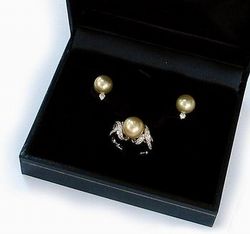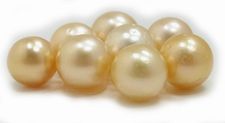| Tahitian Pearls, South Sea Pearls, Discount Pearl Jewelry |

|
|
 |
• About of Our Pearls
• 45-Day Guarantee
• Pearl Education
1-888-869-8889
|
 |
|
|
Outstanding Service, Quality Pearls, Elegant Presentation |
|
|
|
We ship our jewelry from our San Diego, CA location:
 In elegant velvet-lined gift boxes In elegant velvet-lined gift boxes
 Accompanied by a Certificate of Authenticity Accompanied by a Certificate of Authenticity
 Prepared by a GIA Graduate in Pearls.
We make sure that the recipient will be impressed with the quality of the jewelry, as well as the quality of the presentation! Prepared by a GIA Graduate in Pearls.
We make sure that the recipient will be impressed with the quality of the jewelry, as well as the quality of the presentation!
|
 |
All of our pearls are natural in color and not enhanced in any way.
For more information about Pearls and Pearl cultivation, scroll down...

|
|
|
|
Pearl Necklace Collection
|
Certificate of Authenticity | Pearl Grading
|
We provide a Certificate of Authenticity with each piece of jewelry that we sell, guaranteeing that each pearl we sell is indeed of natural color and export quality.
We guarantee that all of our Tahitian pearls were grown in the warm lagoons of French Polynesia (Tahiti). We do not sell black-market pearls or pearls from the Cook Islands that are also uninspected. |
Pearl Grading |
Pearl Grade |
French
Polynesia
Scale |
Description |
AAA |
A |
Pearl is flawless on 90% of the pearl's surface. Only one deep blemish is permitted. Nacre is very thick and luster is very high. |
AA+ |
A/B |
Pearl is flawless on 80% of the pearl's surface. One to two deep blemishes are permitted. Lighter blemishes may also be present, but the pearl faces up clean. Nacre is very thick and luster is high to very high. |
AA |
B |
Pearl is flawless on 70% of the pearl's surface. Nacre is very thick and luster is high to very high. |
A+ |
C |
Pearl shows blemishes on 60-70% of the pearl's surface. Nacre is thick to very thick and luster is medium to very high. |
B |
D |
Not sold on our site. |
|
|
|
|
 We are a full service jeweler.
We are a full service jeweler.
If you cannot find exactly
what you are looking for, please email us or call
toll-free 1-888-869-8889
and let us help. |
About Pearl Cultivation | About Tahitian and South Sea Pearls
|
Tahitian pearls, the official designation of pearls grown in the waters of French Polynesia, are among the most sought-after pearls in the world. Sometimes generically called black pearls or Tahitian black pearls, these pearls are found in an astonishing range of natural colors, from creamy white, light gray, and dark gray, to incredible greens, blues, yellows, and purples. Tahitian pearls in "fancy" colors of like aubergine, pistachio, deep blue-green, are rare and highly prized.
|
|
| Rangiroa Atoll, Tuamotu Archipelago, French Polynesia |
Starting in the 1950's, the government of French Polynesia began instituting a number of programs and laws to convert Tahitian Pearl production from natural harvesting to pearl farming and pearl cultivation. This was due to the fact that, since only a tiny percentage of oysters naturally yielded pearls, natural pearl production was decimating the population of the local black-lipped oyster, the Pinctada Margaritifera.
So, In accordance with French Polynesian law, all Tahitian Pearls are now cultivated, or cultured. It is not permitted to sell newly harvested, natural Tahitian pearls (as opposed to new, cultured Tahitian pearls).
Tahitian Pearl production takes place throughout French Polynesia, but the greatest concentration of pearl farms is located in the coral atolls of the Tuamotu Archipelago, a few hundred miles west of Tahiti. Pearl cultivation begins with the careful farming of black-lipped oysters. The young oysters (known as spats) that spawn from mature black-lipped oysters are captured in artificial collectors suspended underwater at 3-5 meters (10-16 ft) below the surface. The spats remain in the collectors for up to three years, where they are cleaned every few months. Once a year, spats that have successfully attached themselves to the collectors are moved to deeper water and placed on long lines at depths of 5-7 meters (16-23 ft), where they continue to mature and grow for at least two years. Once the oysters have matured on the lines, they are ready for grafting. |
|
|
Customer satisfaction is
our #1 goal! Read what
our satisfied customers
have to say on our
testimonials page and
check our return policy.
We are proud members
of the San Diego Better
Business Bureau and the
BBB Online Reliability Program. We are pleased to have earned an A+ rating from the BBB by adhering to the highest business ethics and having no complaints filed in the history of our business!
|
|
A Pearl Graft Taking Place |
Natural pearls are formed when a foreign material, such as grain of bacterium, accidentally makes its way into an oyster. The oyster reacts to this invasion by secreting a substance called nacre, which surrounds the offending material. Over many years, the oyster deposits many layers of nacre on the invader, resulting in a pearl. By contrast, pearl cultivation involves inserting foreign material into the mother oyster by hand, initiating the nacre build-up artificially.
The pearl grafting process begins by prying apart a donor oyster, one which preferably has brightly colored mother-of-pearl on the shell inside. Then, a narrow portion of a donor black-lipped oyster's lip, or secretory mantle, is sliced and then cut into short sections. A single lip section is disinfected and then placed on a nucleus, a solid 6-9mm sphere made from the shell of Tennessee and Mississippi river mollusks. Next, the host oyster, which was recently induced to spawn in order to expend its excess energy, is secured on a shell stand. Carefully, the host oyster is pried apart, but only enough to insert surgical instruments. An incision is made into the host oyster's reproductive organ, into which the nucleus and lip graft is then inserted. The donor lip section will imprint the color of the donor mother-of-pearl which used to surround it onto the nacre being deposited on the nucleus.
The pearl grafting process has many pitfalls: the host oyster has a 10-40% chance of dying as a result of the graft. The oyster may be sufficiently "upset" by the operation that it will not produce a high-quality pearl. In addition, the nucleus may be rejected and expelled from the oyster. If the nucleus is expelled, it may be possible to insert a second nucleus next to the original graft. If the graft is successful, the host oyster will coat the nucleus with nacre over a period of eighteen months to two years, at which point the pearl is ready for harvesting.
Once the pearl is harvested, the same oyster can receive a larger nucleus and lip graft. A single healthy oyster may produce three or four pearls in its lifetime. The value of an individual pearl will be determined by its size, shape, and quality. Tahitian pearls usually range in size from 7mm to 14mm, with an average size of 9mm. Larger Tahitian pearls, 15-18mm in diameter do exist, but They are extremely rare. The largest Tahitian pearl grown so far was an incredible 21mm in diameter!
|
|
|
|
|
Round, Semi-Round, Semi-Baroque, Baroque, and Circle Pearls
|
Tahitian pearls and South Sea Pearls come in a variety of shapes, listed here in order of desirability: Round, semi-round, semi-baroque, baroque, and circle. Pearls classified as round have less than a 2% variation in diameter, and are the rarest of Tahitian Pearls, accounting for about 5% of total pearl production. Semi-round pearls have less than a 5% variation in diameter. Semi-baroque pearls have at least one axis of rotation, and can be further classified into drop, button, pear, and oval shapes. Baroque pearls have no axis of rotation.
The quality of a Tahitian Pearl is graded as an "AAA", "AA", "A", or "B" (In French Polynesia, the grades are "A", "B", "C", or "D"), depending on the luster and surface purity of the pearl. A "AAA" pearl should have superior luster and either no small blemishes or a few blemishes on less than 10% of its surface. A "AA" or "AA+" pearl should have above-average luster and a few blemishes on less 1/3 of its surface. A "A" pearl should have average luster and blemishes over less than 2/3 of its surface. A "B" pearl should have below-average luster and blemishes over its entire surface.
Tahitian Pearl production and export are strictly regulated by the government of French Polynesia. Every pearl intended for export is x-rayed by the Tahitian Pearl Ministry to ensure that the nacre thickness meets the minimum requirements for export, 0.6mm before July 2002, 0.8mm after. In addition, the blemishes often present on the pearl surface must be fairly shallow, or the pearl will fail inspection. Pearls that do not meet the export criteria are destroyed at the inspection facility.
|
|
|
|
|
TahitianPearls.Biz 1-888-869-8889 toll free in US customerservice@tahitianpearls.biz
International dial 001-858-349-5088
Mailing Address: 2658 Del Mar Heights Rd. #252 Del Mar, CA 92014 (not a showroom)
©2004-2010 Reingold Imports Inc. |
|
|

